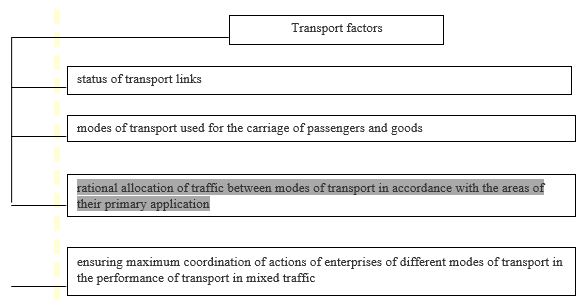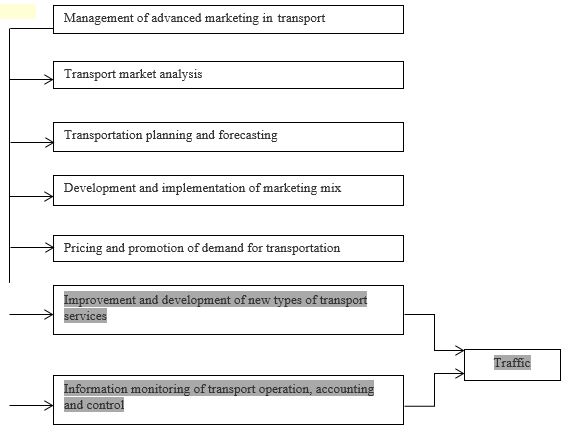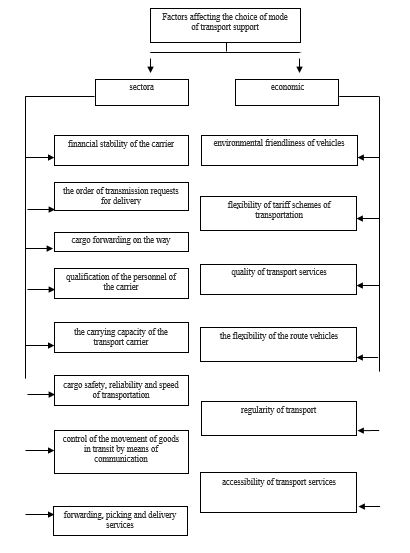Abstract
The transition to modern, civilized forms of development of the transport market forces businesses to turn to marketing opportunities, to implement its principles and methods in the daily activities of transport companies. The main role in this issue is given to modern means of marketing communications, branding, principles of interaction with customers, marketing pricing and a number of other marketing tools. The complex of advanced marketing in the transport industry is a system of favorable conditions for the implementation of services on the basis of a comprehensive study of the market, planning and forecasting of the company aimed at networking with contractors. In these conditions, innovative market development tools play an important role, and the role of transport factors in the development of markets is significant and diverse. The special situation of transport factors is explained by the fact that transport infrastructure supports and simplifies commercial activities. The efficiency of transport increases, and the value of the transport factor decreases with the improvement of transport. Marketing involves planning in the transport industry and is aimed at identifying consumer issues with the aim of operational orientation of services to their satisfaction. The article deals with transport factors that play a significant role in the development of the country's economy in terms of advanced marketing. Their groupings by characteristics, modes of transport and transport infrastructure are given. The factors influencing the choice of the method of transport support are revealed.
Keywords: Marketingdemandservicestransportfactorcomplex
Introduction
Industry features in the management of advanced marketing should be considered in the transport industry based on the influence of transport factors on the economic development of the country. The transport industry is important for the Russian Federation at the expense of its vast territory and is a complex and multifunctional mechanism consisting of vehicles, infrastructure, service companies, means of communication, roads, highways, and includes land, air and water transport. Transport factors are a set of types and objects of transport, transport communications and the functions they perform, and are one of the main components of their own development potential and changes in the spatial component structure (Marchetti & Wanke, 2019). The main directions of development of the transport industry are determined by state policy and include the development of infrastructure of affordable and safe transport links between the territories of the country and the world, ensuring the sustainability of the transport system by creating reasonable reserves and maintaining the regulatory characteristics of the network, as well as developing transport infrastructure for integrated development of territories.
The purpose of the article is to consider industry-specific features in the management of advanced marketing based on an analysis of the transport of goods and passengers, freight and passenger traffic, respectively, by means of transport for the period from 2016 to 2018.
Problem Statement
At the present stage, there are a number of problems, consisting in the lack of analysis of transport factors from the perspective of advanced marketing, increasing the unevenness use of the management tool for the development of the transport system and the transport industry. The combination of these trends against the background of the projected growth in demand in the market of transport services poses a threat to economic growth and entails a loss of competitiveness due to the lack of marketing plans for services. Solving the problem of effective development of the transport industry is necessary for the successful management of the country's economy.
Research Questions
Transport factors are characteristic of all modes of transport and characterize the level of socially necessary costs for the provision of services, while assessing the efficiency and quality characteristics of transport services on the entire route. The content of transport factors is shown in figure

The rational distribution of traffic between modes of transport reflects the place and role of each of them in the economy of the country and is decisive for the management of advanced marketing. The transport process is shown in figure

The second element of the transport process is crucial for the management of advanced marketing. Therefore, management of advanced marketing in transport should include the main stages shown in figure

The effective functioning of the transport sector and transport factors is impossible without the use of modern marketing technologies and the implementation of marketing policy (Firstov, Samuilov, & Gashkova, 2015). Marketing activities have a significant impact on the development of the entire transport sector in Russia (Vasilenko, Drozdov, Tagiltseva, Kuzina, & Kuzina, 2017).
In the conditions of development of market relations, advanced marketing creates the most favorable conditions for production, sales of products, provision of services on the basis of comprehensive market research, planning and forecasting of the corporation's activities aimed at network interaction with contractors using transport factors (table
The volume of cargo transportation by all modes of transport as a result 2018 increased compared to 2017 by 2%, in 2017 and in 2016 by 0.8%. This was facilitated by the growth of trade turnover within the country.
Following the results, in 2018 road transport transported 5548.9 6 million tons of cargo, in 2017 - 5444 million tons of cargo. At the same time, the share of road transport in the total volume of cargo transportation was 80.8%, which was by 0.2% below the level of 2016. This decrease is due to the increase in tariffs for road transport. The growth of tariffs in Russia was due to the introduction of a system of charging for vehicles "Platon" and introduced in 2015. Payments on account of compensation of the damage that heavy trucks cause to the roads of Federal importance. Share of rail transport in total in 2018 compared to 2017 increased by 1.9 %, and in 2017 increase compared to 2016 made 18.8%. This is due to the reduction of tariffs for rail transport. Share of cargo transportation by sea in 2018 decreased compared to 2017 by 6.1%. Air transport transported in 2017 1.1 million tons of cargo 0.1 million tons more than in 2018. This is due to the fact that in 2017 routes to Turkey and Egypt were opened. This factor led to an increase in passenger traffic and gave relevance to transport marketing. In 2017, the growth of transportation of goods by pipeline increased compared to 2016 by 4.1% and by 7.6% in 2018 and is associated with the growth of oil production by 0.5%, gas - by 13.3%, oil products - by 0.8%.
The organization of the transportation process combines a set of measures: the choice of vehicle type, transportation marketing, traffic safety, control and elimination of failures during transportation. An important criterion for assessing the operation of the transport system is the turnover (Fursov, 2006).
Freight rail transportation in Russia has a large turnover among all modes of transport and is the most popular mode of transport. The share of railway transport accounts for about 85% of the total turnover of the country. Sea and air transport also increased by 6.5 % and 15.2%, respectively, and in 2018, with an increase of 0.2 billion tons/km of air transport, there is a decrease in sea transport by 1 billion tons/km. This is due to the development of terminal capacities by the largest shippers. The popularity of rail transport is associated with its cheapness compared to vehicles. Water transport has a lower cost, but in the harsh Russian climate it can be operated only 6-7 months a year.
In railway transport, a large cargo turnover is achieved due to long distances (an average of 1573 km), to which goods are delivered (Macheret & Kudryavtseva, 2016). Road transport has large indicators for the quantitative transport of goods. It accounts for 68% of all transported cargo. This is due to the mobility of vehicles. With the development of navigation satellite technologies, the logistics of road transport has become effective. With the help of satellite systems are selected the optimal routes and vehicles are always under the control of the operator-logistician. The increase in the turnover of pipeline transport in 2018 by 2% is due to an increase in oil production and an increase in the production of petroleum products. The transportation process is based on the organizational, technical and technological interaction of different modes of transport and the broad development of intermodal and multimodal transport on logistics principles. To this end, all major cargo-forming and cargo-absorbing transport hubs are creating logistics canters and terminals, including covered warehouses and sites with appropriate equipment, transhipment equipment, dispatching and information systems for traffic management. They includ the collection and processing of orders from the clientele, notification of the arrival and dispatch of goods, information on the location of goods and vehicles, maintaining a single document flow, orders for mobile vehicles, organization of calculations, cargo insurance and technical means (Galaburda, 2011). The transport system of the Russian Federation is the most important link of foreign trade exchange with foreign countries, significantly affecting its nature, scale and results.
Currently, the role of Russia in world trade in transport services is significant, which ensures its entry into the top 30 countries participating in trade exchange (Tereshina & Soroka, 2014). In addition to cargo transportation, passenger transportation plays an important role, which is an important factor in the economic and social development of Russia (Han, Ouyang, & Wang, 2018). The cost of passenger transportation is calculated at different rates, based on the total number of passenger traffic. Long-distance routes occupy about 70% of all passenger-km, and suburban and intercity - 30%. The Russian market of railway transport is completely monopolized. 99% of railways and infrastructure, 91% of all locomotives, and about 25% of all freight cars belong to the state company "Russian Railways" (Sokolov & Lavrov, 2015).
In 2018, in order to increase traffic volumes and increase profitability, large-scale marketing campaigns and initiatives were implemented.
- a 50% discount on travel on the upper shelves in compartment cars of all trains of domestic communication;
- a 20% discount on travel in ST cars and compartment cars of trains;
- a 30% discount on travel on the upper shelves of compartment cars on selected routes;
- a 50% discount on travel on the upper shelves of compartment cars for students;
- differentiation of tariffs depending on the date of purchase of tickets:
- a 50% discount when booking a ticket from 45 to 31 days before the departure of the train, a 5% surcharge when booking a ticket from 10 days or less before the departure date.
In order to increase the volume of transportation by attracting customers, it is necessary to master modern advanced technologies of competitive companies, their marketing strategies and relationships with customers and contractors (Galaburda, 2003). Road transport is characterized by a large indicator of the quantitative transport of passengers. Its share in 2017 - 2018 accounted for 90.6% of all passengers. Water transport in Russia is practically not used for the transportation of passengers, at the end of 2017, 11.7 million passengers were transported, in 2018, there was a decrease in this indicator. At the end of 2018, the total passenger turnover increased by 3.2 %. The resumption of flights to Turkey and Egypt contributed to the restoration and increase in passenger air transport.
Air transport is the fastest mode of transport and has the largest passenger turnover among all modes of transport, which in 2017 amounted to 259384. 9 million passengers-km, and in 2018 - 286300.7 million passengers-km. This figure is achieved due to the distance at which passengers are delivered. Compared to 2016, the number of passengers transported by air in 2017 increased by 20.3%, and in 2018 the growth was 10.4%. Air transport is a strong competitive threat to rail transport. Competitive advantages of airlines are: speed, time of delivery of passengers, lack of price regulation and higher price, commercial and marketing flexibility of airlines (Drozdov, Tagiltseva, Vasilenko, & Kuzina, 2017).
The peculiarities of marketing management of transport include: the objective conditions of restricting competition on the transport market, the benefits of interaction modes; differences of marketing techniques in the implementation of transport services for freight and passenger traffic; the need for complexity, the efficiency of the process of marketing management; the flexibility of the tariff policy; integrated marketing agencies in the structure of major transport companies, companies and firms; the feature of personnel policy, requiring highly skilled managers of marketing; the importance of the systematic use of the concept of marketing and strategic planning, a reliable foresight of the situation on the transport market (Meioh, 2014). In the conditions of advanced marketing, there are factors that affect the choice of the method of transport support, which are presented in figure

Purpose of the Study
The main purpose of the organization of management of the complex of advanced marketing in transport is the formation of effective demand for transport in order to ensure a stable financial and economic situation of transport enterprises.
Research Methods
When carrying out the study by the example of the transport industry, we used the marketing and logistics approach and economic analysis by type of transport.
Findings
The growth of industrial production by at least 2% annually will contribute to the growth of commercial cargo transportation and commercial cargo turnover in the medium term. The implementation of investment projects, as well as improving the efficiency of management of railway traffic of JSC "Russian Railways", the growth of local speed on the railway and reducing the turnover of the car will weaken the infrastructure restrictions of the transport market and reduce the imbalance between the needs of the economy and the capacity of the transport network. The growth of exports of raw materials, in particular the growth of coal exports by 3-3.5% annually will have a positive impact on the dynamics of transportation and freight turnover by rail. The positive dynamics of retail trade and the growth of investment in the economy as a whole will contribute to the growth of road freight and road transport turnover by an average of 3.8% per year. Maritime transport and its maritime transport market are among the most important sectors of the modern world economy. Modernization of storage systems, warehouses, cargo areas, the implementation of a separate investment program to upgrade gantry cranes and handling equipment in General will increase the transportation of goods by sea. To expand the competitive capabilities of air transport and improve the quality of service will increase the speed and increase passenger capacity, the creation of Airbus, increase the carrying capacity of aircraft, as well as the creation of short and vertical take-off and landing aircraft for civil aviation, increase fuel efficiency.
Conclusion
In the course of the analysis it was revealed that the management of the complex of advanced marketing in the transport industry is based on activities that determine the methods, tools and techniques aimed at improving the competitiveness of individual modes of transport. Features of management of a complex of advanced marketing in the transport branch can be applied in other branches and fields of activity.
References
- Drozdov, N. А., Tagiltseva, J. A., Vasilenko, M. A, & Kuzina, E. L. (2017). Modeling of efficiency assessment for enterprises economic activity in environmental system. In 2017 IEEE Conference on Quality Management, Transport and Information Security, Information Technologies (IT&MQ&IS) (pp. 705–709). https://dx.doi.org/10.TMQIS.2017.8085926
- Firstov, S. V., Samuilov, V. M., & Gashkova, L. V. (2015). From business strategy to it solutions for transport logistics. Transport systems of the country, its regions and cities, the organization of production in transport, 4, 38–45.
- Fursov, V. A. (2006). Features of marketing of transport services. Economic Bulletin of Rostov state University, 4, 148–152.
- Galaburda, V. G. (2003). The concept of marketing activities of Railways in the context of their reform. Economics of railway transport, 3, 42–47.
- Galaburda, V. G. (2011). Transport marketing. Textbook. Moscow: Training center on education on railway transport.
- Han, B., Ouyang, Z., & Wang, W. (2018). The relationship between regional industrial organizing levels and ecological economic efficiency. Journal of Cleaner Production, 171, 857–866. DOI:
- Macheret, D. A., & Kudryavtseva, A. V. (2016). On evaluating the effectiveness of investments in innovative projects. Railway Economics, 12, 21–26.
- Marchetti, D., & Wanke, P. F. (2019). Efficiency in rail transport: Evaluation of the main drivers through meta-analysis with resampling. Transportation Research Part A: Policy and Practice, 120, 83–100. DOI:
- Meioh, Z. P. (2014). Process approach to building a risk management system for transport companies. Transport business of Russia, 4, 177–181.
- Sokolov, Y. I., & Lavrov, I. M. (2015). Improving the quality of transport services. Railway Economics, 8, 76–81.
- Tereshina, N. P., & Soroka, I. Yu. (2014). Cost management of the transport company on the basis of process-oriented approach. Transport business of Russia, 1, 55–58.
- Vasilenko, M. A., Drozdov, N. A., Tagiltseva, Y. A., Kuzina, E. L., & Kuzina, M. A. (2017). Systematic approach and advanced marketing in public-private partnerships. In IEEE Conference on Quality Management, Transport and Information Security, Information Technologies (IT&MQ&IS), 10. TMQIS.2017.8085753
Copyright information

This work is licensed under a Creative Commons Attribution-NonCommercial-NoDerivatives 4.0 International License.
About this article
Publication Date
28 December 2019
Article Doi
eBook ISBN
978-1-80296-075-4
Publisher
Future Academy
Volume
76
Print ISBN (optional)
-
Edition Number
1st Edition
Pages
1-3763
Subjects
Sociolinguistics, linguistics, semantics, discourse analysis, science, technology, society
Cite this article as:
Vasilenko*, M., Kuzina, E., Drozdov, N., Tagiltseva, Y., & Bortnik, O. (2019). Industry Features In The Management Of Advanced Marketing Complex. In D. Karim-Sultanovich Bataev, S. Aidievich Gapurov, A. Dogievich Osmaev, V. Khumaidovich Akaev, L. Musaevna Idigova, M. Rukmanovich Ovhadov, A. Ruslanovich Salgiriev, & M. Muslamovna Betilmerzaeva (Eds.), Social and Cultural Transformations in the Context of Modern Globalism, vol 76. European Proceedings of Social and Behavioural Sciences (pp. 3282-3290). Future Academy. https://doi.org/10.15405/epsbs.2019.12.04.441
